You can freeze pita bread, and pitas freeze really well. The whole process takes only a couple of minutes and doesn’t require anything besides some freezer bags and perhaps aluminum foil or plastic wrap.
Similar to naan bread and tortillas, freezing pitas is a great way to save any leftovers to use as needed. And it allows you to cook several batches on the weekend so that you have some available throughout the week (or weeks) ahead.
In this article, we’re going to talk about:
- how to go about freezing pita bread, and how much wrapping you really need
- ways to defrost and reheat frozen pitas
- using your leftover pitas after reheating
Sounds good? Let’s jump right in.
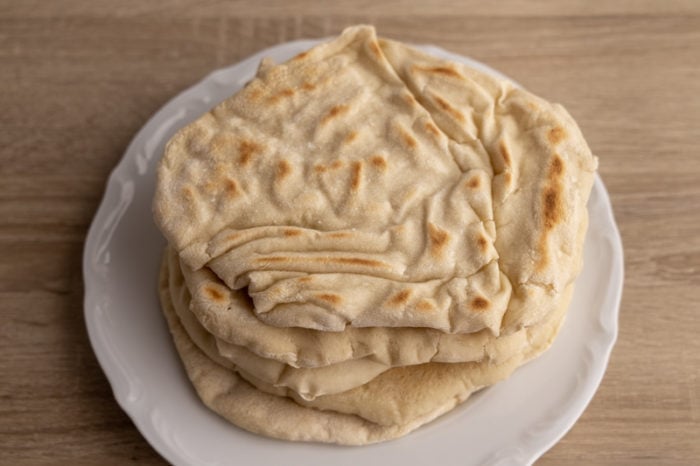
How To Freeze Pita Bread
Here’s how you freeze pita bread:
- Place pitas in a freezer bag or bags. Feel free to place as many in a single bag as you like. Despite what other sites say, pitas don’t stick together when frozen, so you don’t have to place anything between them to be able to grab only a few from the bag. When it comes to wrapping individual pita breads, it all depends on how long the flatbreads will sit in the freezer. I talk about it in detail in the next section. Last, squeeze out as much air from the bag as possible before sealing it.
- Freeze. Before placing the bag in the freezer, consider adding a label with the name and date if you find that helpful.
That’s it. Your pitas are safe and secure in the freezer.
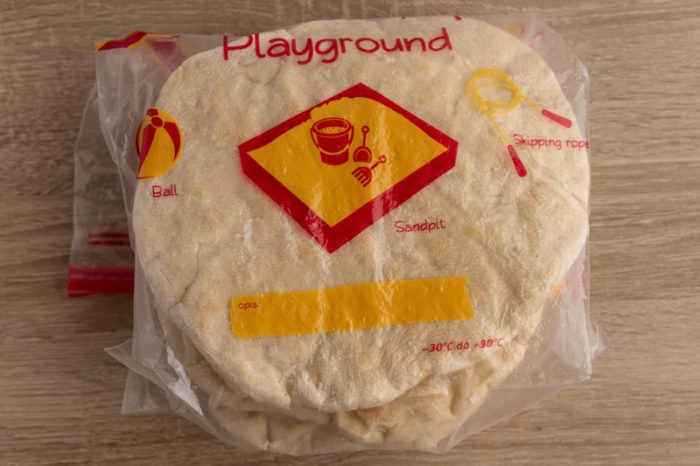
Avoiding Freezer Burn
If you plan on consuming all your frozen pita breads within a month or so, they don’t really need any extra wrapping besides the freezer bag that keeps them together. They still retain quality quite well.
But if your pitas might sit in the freezer for longer, individual wrapping is worth considering.
If you want your pita breads to keep their quality for as long as possible, wrap each one with aluminum foil, plastic wrap, or even freezer wrap. Once they’re single-wrapped, they still go into a freezer bag for that extra bit of protection.
For me, I try to use only reusable wrapping if possible, so I stick with storing all the pitas together in a freezer bag, without any extra wrapping. And I save on using a lot of plastic in the process, which is also nice.
(Sometimes individual wrapping is a must, as is the case in freezing fresh yeast.)
If you want to stick to using reusable equipment but still single-wrap each pita, you can place each pita bread in a separate bag and then all the bags into another, larger one. That will help with avoiding freezer burn too.

How Long Can You Freeze Pita Bread?
Try to use your frozen pita breads within three months of freezing for the best quality.
Don’t treat those three months as a line in the sand that if your pitas cross it, you should discard them. Instead, it’s just a suggestion on how to get the most out of them flavor-wise.
Pita breads frozen for 4 or even 6 months will still be just fine. Probably a bit drier than those frozen for a much shorter period, but that’s about it. With some delicious stuffing, they will taste quite good.
The important thing here is that you remember that those pitas sit in the freezer so that they don’t wait for you to use them for a year or two. After such an extended period, they probably won’t taste all that great.
For me, I try to use frozen baked goods (including bread and bread pudding) within a month. If they sit in the freezer for longer, I tend to forget about them, and that’s an easy way to end up with year-old pitas.
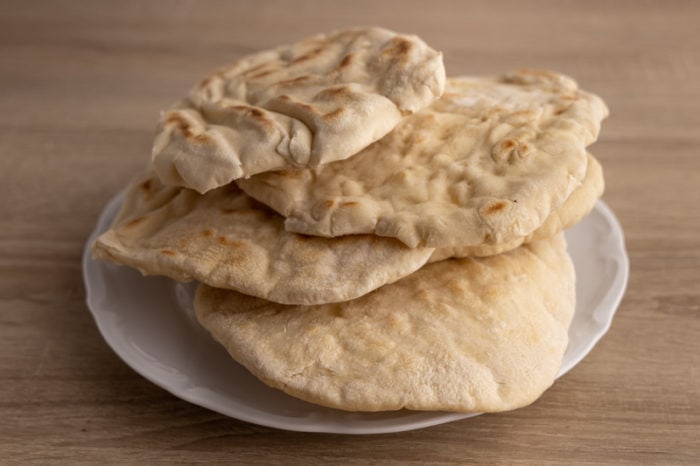
How To Defrost and Reheat Pita Bread
There are a couple of ways to defrost and reheat pita breads. Pick one that best fits your needs and circumstances.
On a Non-Stock Pan
Put the pan on medium heat (no fat), and place the pitas in a single layer. Give that pan a shake every 20 seconds to make sure the flatbreads don’t stick.
After 2 to 4 minutes, your pitas should be defrosted and pretty warm. That’s when you flip them to the other side and leave them on the pan for another minute or two so that they’re thoroughly warmed.
If you’re worried that your pitas will dry out, try spritzing a bit of water on top right after placing them on a pan. Or lightly dampening the top with wet hands if you don’t have a mister or a spray bottle on hand.
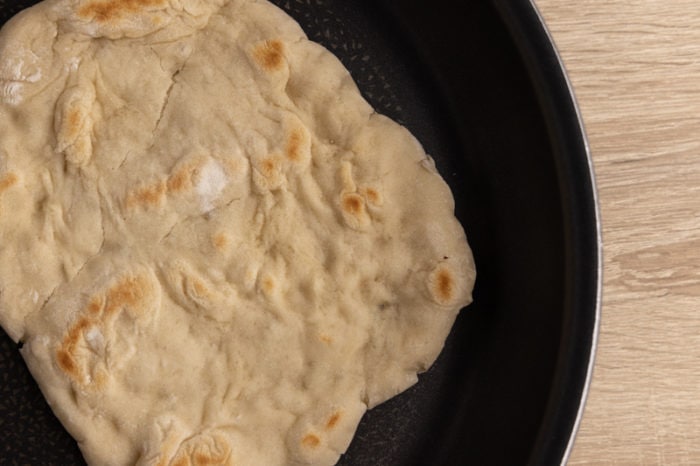
On the Counter
Place your pitas in a single layer on a bunch of plates (or what have you) on the counter. After 30 to 40 minutes, they should be defrosted and ready for reheating.
If you want to speed up the process a bit, flip them after the initial 15 minutes so that the other side starts to thaw earlier.
That’s my favorite method of defrosting pita breads. I get them from the freezer when I start working on the dish that I’m cooking, and by the time I’m ready, they are defrosted and only need a couple of minutes on the stove (see above) to reheat.
In the Microwave
Start by setting the microwave on defrost setting (or 50% to 60% power), and microwave them in 30 seconds increments (or longer, if you have a bunch of pitas) until defrosted.
Then, set the device on full power, and nuke your pita breads in short 15 to 20-second increments until warm enough to your liking. For best results (all pitas warmed up properly), microwave one to three at a time, instead of a stack of 7.
If your pitas tend to dry out in the microwave, try placing a dampened paper towel on top of each pita (or between pitas, if they’re stacked). That should help mitigate the issue.
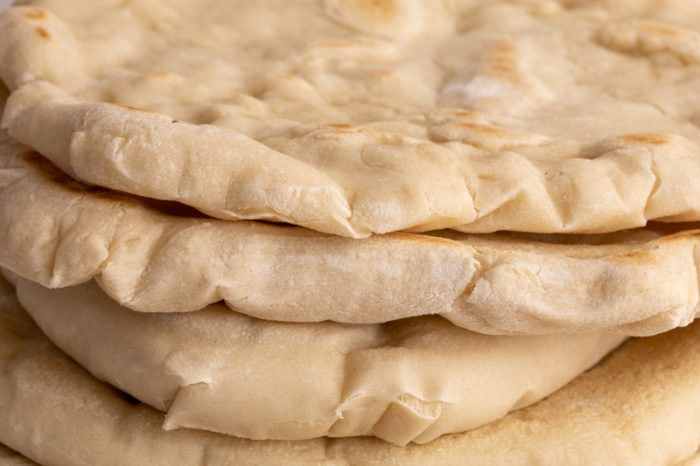
In the Oven
I don’t like defrosting or reheating pitas in the oven because it’s difficult to get it right.
With other methods, it’s pretty easy to control how things are going. You can touch the pita bread to learn if it’s defrosted or how warm it is.
In the case of the oven, opening it every 20 seconds to give the pitas a check is pretty inconvenient, to say the least. And it gets much worse if you dampen the pitas and wrap them in aluminum foil to prevent them from drying.
In short, try one of the other methods that I described.
Tip on Preventing Pitas From Drying
If you’re sprinkling your pitas with water for the first time ever, do a test run with a single pita. That should help you figure out how much water you need to keep the pitas from getting dry, but also not too much so that they get soggy.
For me, I use the combination of defrosting on the counter and reheating on a non-stick pan and don’t find the pitas too dry. But that’s just me.
Using Defrosted Pita Bread
You can use defrosted pita breads exactly the same way you use fresh ones. That includes:
- stuffing them (dishes like shawarma, or your favorite mix of meat and salad come to mind)
- eating them alongside your favorite stews or soups (as an alternative to bread)
- using them to scoop sauces or dips (e.g., hummus)
- ordering takeout but skipping the pitas
- whatever else you can think of
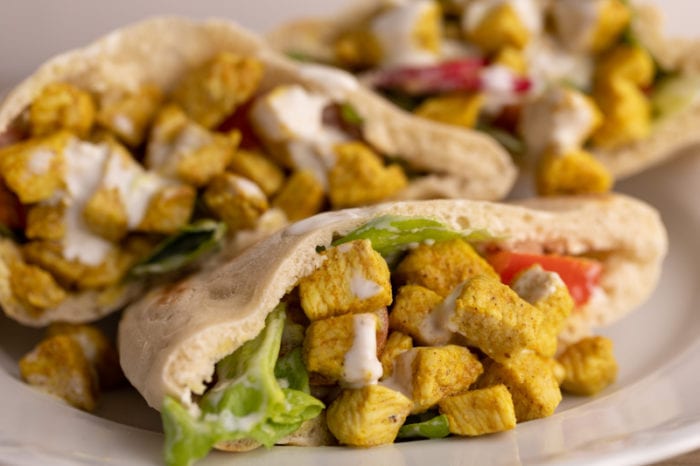
If you’re looking for some creative ideas, search for recipe blogs covering the Mediterranean or Middle East cuisines. There are approximately a bazillion recipes in those cuisines that use pitas as the star of the dish or as a side.
For the photos in this article, my wife cooked some cubed chicken breast and came up with a simple salad with lettuce, red bell pepper, and cherry tomatoes, and topped it all with garlic sauce. Simple, yet super tasty.